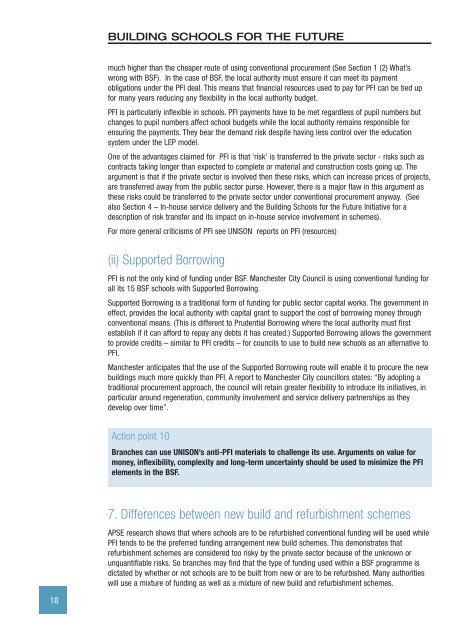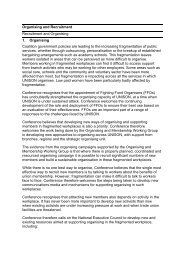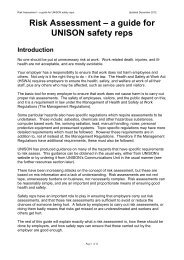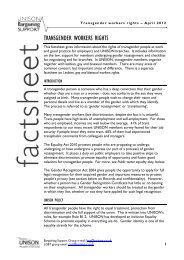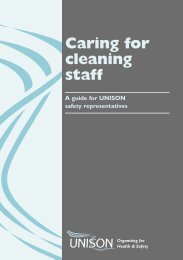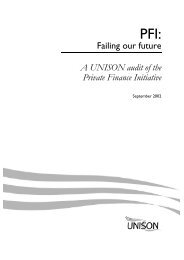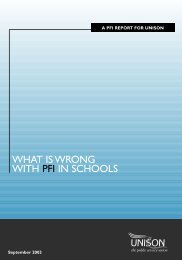Building schools for the future - Unison
Building schools for the future - Unison
Building schools for the future - Unison
Create successful ePaper yourself
Turn your PDF publications into a flip-book with our unique Google optimized e-Paper software.
18<br />
BUILDING SCHOOLS FOR THE FUTURE<br />
much higher than <strong>the</strong> cheaper route of using conventional procurement (See Section 1 (2) What’s<br />
wrong with BSF). In <strong>the</strong> case of BSF, <strong>the</strong> local authority must ensure it can meet its payment<br />
obligations under <strong>the</strong> PFI deal. This means that financial resources used to pay <strong>for</strong> PFI can be tied up<br />
<strong>for</strong> many years reducing any flexibility in <strong>the</strong> local authority budget.<br />
PFI is particularly inflexible in <strong>schools</strong>. PFI payments have to be met regardless of pupil numbers but<br />
changes to pupil numbers affect school budgets while <strong>the</strong> local authority remains responsible <strong>for</strong><br />
ensuring <strong>the</strong> payments. They bear <strong>the</strong> demand risk despite having less control over <strong>the</strong> education<br />
system under <strong>the</strong> LEP model.<br />
One of <strong>the</strong> advantages claimed <strong>for</strong> PFI is that ‘risk’ is transferred to <strong>the</strong> private sector - risks such as<br />
contracts taking longer than expected to complete or material and construction costs going up. The<br />
argument is that if <strong>the</strong> private sector is involved <strong>the</strong>n <strong>the</strong>se risks, which can increase prices of projects,<br />
are transferred away from <strong>the</strong> public sector purse. However, <strong>the</strong>re is a major flaw in this argument as<br />
<strong>the</strong>se risks could be transferred to <strong>the</strong> private sector under conventional procurement anyway. (See<br />
also Section 4 – In-house service delivery and <strong>the</strong> <strong>Building</strong> Schools <strong>for</strong> <strong>the</strong> Future Initiative <strong>for</strong> a<br />
description of risk transfer and its impact on in-house service involvement in schemes).<br />
For more general criticisms of PFI see UNISON reports on PFI (resources)<br />
(ii) Supported Borrowing<br />
PFI is not <strong>the</strong> only kind of funding under BSF. Manchester City Council is using conventional funding <strong>for</strong><br />
all its 15 BSF <strong>schools</strong> with Supported Borrowing.<br />
Supported Borrowing is a traditional <strong>for</strong>m of funding <strong>for</strong> public sector capital works. The government in<br />
effect, provides <strong>the</strong> local authority with capital grant to support <strong>the</strong> cost of borrowing money through<br />
conventional means. (This is different to Prudential Borrowing where <strong>the</strong> local authority must first<br />
establish if it can af<strong>for</strong>d to repay any debts it has created.) Supported Borrowing allows <strong>the</strong> government<br />
to provide credits – similar to PFI credits – <strong>for</strong> councils to use to build new <strong>schools</strong> as an alternative to<br />
PFI.<br />
Manchester anticipates that <strong>the</strong> use of <strong>the</strong> Supported Borrowing route will enable it to procure <strong>the</strong> new<br />
buildings much more quickly than PFI. A report to Manchester City councillors states: “By adopting a<br />
traditional procurement approach, <strong>the</strong> council will retain greater flexibility to introduce its initiatives, in<br />
particular around regeneration, community involvement and service delivery partnerships as <strong>the</strong>y<br />
develop over time”.<br />
Action point 10<br />
Branches can use UNISON’s anti-PFI materials to challenge its use. Arguments on value <strong>for</strong><br />
money, inflexibility, complexity and long-term uncertainty should be used to minimize <strong>the</strong> PFI<br />
elements in <strong>the</strong> BSF.<br />
7. Differences between new build and refurbishment schemes<br />
APSE research shows that where <strong>schools</strong> are to be refurbished conventional funding will be used while<br />
PFI tends to be <strong>the</strong> preferred funding arrangement new build schemes. This demonstrates that<br />
refurbishment schemes are considered too risky by <strong>the</strong> private sector because of <strong>the</strong> unknown or<br />
unquantifiable risks. So branches may find that <strong>the</strong> type of funding used within a BSF programme is<br />
dictated by whe<strong>the</strong>r or not <strong>schools</strong> are to be built from new or are to be refurbished. Many authorities<br />
will use a mixture of funding as well as a mixture of new build and refurbishment schemes.


